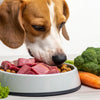Should I Soak My Dog's Kibble? Understanding the Benefits and Best Practices
- Houndsy
Table of Contents
- Introduction
- Understanding Dry Dog Food
- The Benefits of Soaking Dog Kibble
- Potential Drawbacks of Soaking Kibble
- Best Practices for Soaking Dog Kibble
- Reflecting on Your Dog Feeding Routine
- Conclusion
- FAQ Section
Introduction
Did you know that a staggering 70% of dogs experience dental issues by the age of three? This alarming statistic raises questions about not only what we feed our furry companions but how we prepare their meals. As pet owners, we often find ourselves contemplating the best ways to ensure our dogs receive optimal nutrition while enjoying their mealtime experience. One question that frequently arises is: should I soak my dog’s kibble?
In this blog post, we will explore the various aspects of soaking dog kibble, including its benefits, potential drawbacks, and best practices. By the end of this article, you will have a comprehensive understanding of whether soaking kibble is the right choice for your dog, and how it could positively impact their overall health and well-being. As we delve into the details, we encourage you to reflect on your own pet feeding routine and consider how small changes can enhance your dog's dining experience.
Understanding Dry Dog Food
Dry dog food, commonly known as kibble, is a staple in many households due to its convenience, cost-effectiveness, and longer shelf life compared to wet food. Typically composed of a mix of meat, grains, vegetables, and essential nutrients, kibble is designed to meet a dog's dietary needs. However, its hard texture can pose challenges for some dogs, especially those with dental issues, aging teeth, or sensitive stomachs.
Nutritional Composition
Kibble is formulated to provide a balanced diet, rich in proteins, carbohydrates, fats, vitamins, and minerals. The nutrient density of dry food means that dogs consume fewer calories when compared to wet food, making it a popular choice for pet owners. However, its hard texture may not always be suitable for all dogs, especially those with specific health concerns or preferences.
The Benefits of Soaking Dog Kibble
Soaking dry dog food involves adding water to the kibble to soften it before serving. This practice has garnered attention for its potential benefits, particularly for dogs with unique needs. Here are some key advantages of soaking kibble:
Enhanced Palatability
Many dogs find soaked kibble more appealing due to its softer texture and enhanced aroma. When water is added, it releases the natural flavors locked within the kibble, making it more enticing, particularly for picky eaters or dogs that have lost their appetite.
Improved Digestion
Soaking kibble can significantly aid in digestion. The moisture helps to break down the food, making it gentler on the digestive system. This is particularly beneficial for puppies, senior dogs, or those recovering from illness, as softened kibble is easier to chew and swallow.
Increased Hydration
For dogs that do not drink enough water, soaking kibble can contribute to their daily hydration needs. This is particularly important for dogs prone to urinary tract infections or kidney issues, as increased water intake can help prevent these conditions.
Reduced Risk of Choking
Soaked kibble is easier for dogs to chew and swallow, which can help mitigate the risk of choking, especially for dogs that tend to inhale their meals. By softening the food, you allow for a more controlled eating pace, which can be particularly crucial for breeds prone to gulping.
Supporting Weight Management
For overweight dogs, soaking kibble can enhance feelings of fullness. When kibble absorbs water, it expands, increasing the volume of food without adding extra calories. This can help dogs feel satisfied with smaller portions, aiding in weight loss efforts.
Potential Drawbacks of Soaking Kibble
While there are numerous benefits to soaking dog kibble, it is essential to consider potential drawbacks as well.
Nutrient Loss
One concern with soaking dry dog food is the potential loss of nutrients if the food is left in water for too long. While moderate soaking is beneficial, prolonged exposure to water can lead to nutrient degradation. Always aim for the recommended soaking times to maintain the food's nutritional value.
Bacterial Growth
Leaving soaked kibble out for extended periods poses a risk of bacterial growth, especially in warmer climates. It’s crucial to serve soaked food promptly and discard any uneaten portions after 15-30 minutes to minimize this risk.
Dental Health Considerations
While some believe that soaking kibble may reduce dental health benefits, it's important to note that not all dogs can effectively chew hard food. For those with dental issues, the benefits of softened kibble can outweigh concerns regarding plaque accumulation. Regular dental care, such as brushing, should still be part of your dog's routine, regardless of the food's texture.
Best Practices for Soaking Dog Kibble
To make the most of soaking your dog's kibble, consider the following tips:
Recommended Soaking Times
The ideal soaking time for dry dog food varies depending on the dog's age, health, and preferences. Here are some general guidelines:
- For Puppies: Soak for 15-30 minutes to ensure the kibble is soft enough for their developing teeth.
- For Adult Dogs: Soaking for 15-20 minutes is usually sufficient.
- For Senior Dogs: Depending on their dental health, soaking for 20-30 minutes can be beneficial.
Use Warm Water
Warm water (about 30-40 degrees Celsius) is ideal for soaking kibble as it helps the kibble absorb moisture more efficiently. Avoid boiling water, as high temperatures can denature nutrients.
Monitor Consistency
After soaking, check the texture of the kibble. It should be soft enough to break apart easily but not mushy. If needed, adjust the soaking time accordingly.
Avoid Prolonged Soaking
Do not leave soaked kibble out for more than an hour to prevent bacterial growth. If you need to prepare food in advance, consider soaking overnight in the refrigerator.
Reflecting on Your Dog Feeding Routine
As you consider the insights outlined above, think about your dog's individual needs and whether soaking their kibble could enhance their mealtime experience.
At Houndsy, we understand that pet care transcends merely feeding; it's about enriching the lives of our furry companions. That’s why our flagship product, the Houndsy Kibble Dispenser, is designed to simplify feeding while maintaining the quality and aesthetics of your home. With features like perfect portion control and a stylish mid-century modern design, we aim to elevate the daily feeding ritual.
To explore how we can enhance your pet's feeding experience, check out the Houndsy Kibble Dispenser.
Conclusion
Soaking dry dog food can be a game-changer for both your dog's health and your everyday feeding routine. By understanding how long to soak dry dog food and the benefits it offers, you can make informed decisions that enhance your pet’s dining experience.
As you reflect on your dog feeding practices, consider trying soaked kibble to observe any changes in their eating habits or overall health. Remember to monitor soaking times, use warm water, and pay attention to your dog's individual needs. At Houndsy, we believe that small adjustments can lead to significant improvements in the lives of our furry companions.
FAQ Section
- How long should I soak dry dog food? Typically, 15-30 minutes is recommended, depending on the dog's age and health.
- Can I soak dry dog food overnight? Yes, you can soak kibble overnight in the refrigerator to prepare for the next meal.
- What type of water should I use for soaking? Use warm water (30-40 degrees Celsius) to facilitate better absorption.
- Is it safe to leave soaked food out for too long? Soaked food should not be left out for more than 15-30 minutes to prevent bacterial growth.
- Does soaking dry food affect its nutritional value? Moderate soaking can enhance digestibility, but prolonged soaking may lead to nutrient loss.
- Should all dogs have their food soaked? Soaking is beneficial for puppies, senior dogs, or those with health issues. Consult your veterinarian for specific advice.
Explore our Houndsy Kibble Dispenser and transform your feeding routine today!












